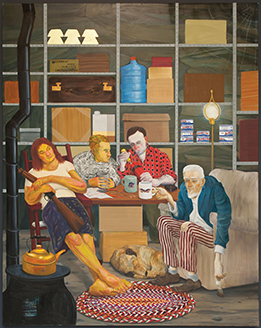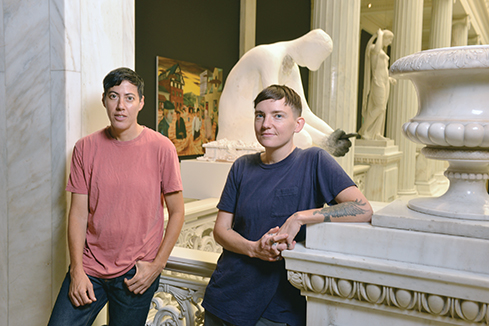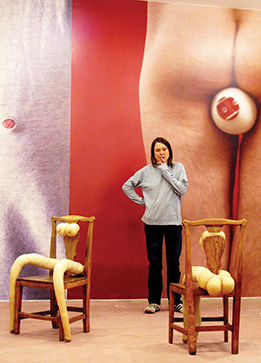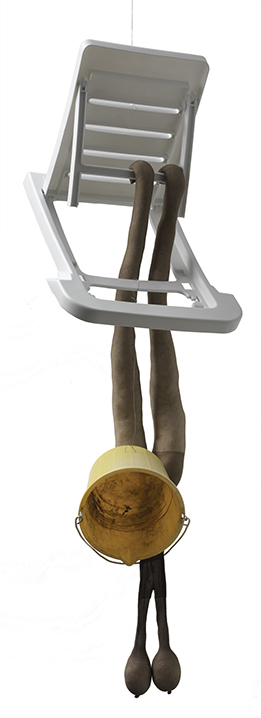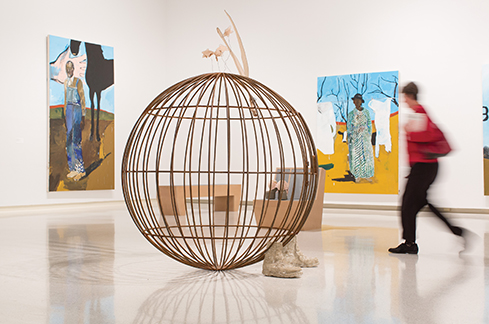 |
||||||||||||||
|
Sarah Lucas’ “Bunnies” |
Energy in human form
Two Carnegie International artists unabashedly objetify the body as a way to celebrate and question what it means to be human. You can think of the 2013 Carnegie International as a type of family reunion. Included in the works—by 35 artists from 19 countries—is a celebration that curators Daniel Baumann, Dan Byers, and Tina Kukielski noticed early on, one that caught them off guard and even forced them to pause in momentary suspicion. What they discovered is the human figure. The subject has ping-ponged in and out of fashion since time immemorial. Often thought to be losing significance in art as the world turns digital, the body, curators observed, has an undeniably strong and complex presence in the 2013 Carnegie International. “I’m personally skeptical of figuration,” says Baumann. “It’s such a dangerous area. That whole language of admiration, of heroism, is all attached and unpleasant.” But the biggest problem with figuration, he says, is nostalgia. “If you go for figures because you are nostalgic about 1,000 years of artists that celebrated the human figure in all different constellations, that, I think, is boring.” Noticing the pervasiveness of the figure in early selections for the 2013 Carnegie International, the team paused, discussed, and came to the following conclusion: When we show the human figure, it will be because the form is not nostalgic but a tool for emancipation or resistance. Baumann points to work by International artists including Rodney Graham, Guo Fengyi, Zanele Muholi, Taryn Simon, Zoe Strauss, and Henry Taylor. Muholi’s arresting black-and-white images make visible the lives of black lesbians in South Africa. Guo’s swirling line drawings show the inner movements of thought, energy, and blood. Taylor’s blunt, expressive paintings place friends alongside heroes of the black liberation movement. “It’s all about using an existing language and fighting back,” says Baumann. Among the artists exploring the human figure in this year’s International are two who do so in three dimensions. Nicole Eisenman and Sarah Lucas use sculpture to consider in various ways what it means for the body to be an object. SEX, POLITICS, AND HEALINGOn permanent display in Carnegie Museum of Art’s Hall of Sculpture is a selection of the museum’s plaster casts of Greek and Roman statues. The second-floor balcony of this beloved space revealed itself early as the ideal place for the work of artist Nicole Eisenman. Her bloated, coarsely textured figures now occupy the empty pedestals between the historic casts. Also composed of white plaster, her figures blend in from a distance, playing a game of hide and seek in plain sight. Rebellious as they take naps, send text messages, and consume what appears to be a giant piece of pizza, they act like little siblings of gargantuan size. But the figures, some traceable by gender and others not, command a closer consideration and soon reveal a quiet, contemplative merit all their own. “The sculptures were an intention to transfer energy or a feeling into plaster form,” says Eisenman, who began working in sculpture in 2011. Known primarily for her painting, Eisenman came to prominence in the 1990s with her darkly funny, almost cartoonish canvases that satirize everything from politics to the nuclear family, art, and gender stereotypes, sometimes all in a single work. These early canvases were bold, feminist, and often sexual, inspired by her experiences as an openly gay artist living in New York City, and earning her the “bad girl” moniker. Recent works take special interest in the present-day political and economic toll on the individual.
Her most recent painting, Tea Party (2011), is similarly dark and demonstrates Eisenman’s ability to remix diverse genres. This time she pulls from 19th-century genre painting; but instead of a pleasant domestic scene of family and hearth, Eisenman offers a dejected group of individuals sitting around a table in what appears to be an underground bunker. The mother holds a gun, the father resembles a deadbeat Uncle Sam, and the brothers are fashioning a homespun explosive. “She has a real mastery of the skills of creating a three-dimensional space with all the complexities and emotions of these characters,” says Kukielski. “But she’s completely subverting our expectations. We’ve stumbled upon these humble, welcoming domestic scenes, yet they’re not like that at all.” Eisenman’s sculptural figures appear to be plucked straight from the narrative scenes of her paintings. “They have the same clunky, unattractive, but also heroic body type, and they’re a kind of all-inclusive gender state,” says Eisenman, who in 2011 went on a “two-year sabbatical” from painting and began working in sculpture. “They have a little bit of everything. I think that’s important.” She says she wanted to create work that used her own body in a different capacity. She points to her head. “Painting is really up here, above the neckline,” she says. “It’s between your eyes and your brain and your brush and your hand. There’s this stick between you and the material. In sculpture you’ve just got your arms around the stuff. They’re bodies and you’re massaging them into life.” For this new approach, Eisenman worked closely with friend Sam Greenleaf Miller, a trained psychologist who works as an art handler and boasts a great knowledge of subjects like tarot card reading, astrology, and healing herbs. “We were definitely cultivating our inner witches in the studio this summer,” says Eisenman of their process. The work began with Eisenman’s notion of a gesture, a figurative pose that occupied her attention. Through conversations with Greenleaf Miller—about the individual, about needs in the world, about creating energy through object—the two fleshed out the backstory, the context for why each character existed. “I think of sculpture as something that holds energy in a way,” says Eisenman. “It’s like when you pick up a pretty stone on the beach. You put it in your pocket, you rub it with your fingers, and you end up keeping it for six months. You feel special about it. I think you can invest energy into objects with certain intentions and they can affect change in the world, and I really like the idea of art as a ritual object that can potentially do that.”
She infused the resulting sculptures with healing elements meant to create, but not necessarily define, rippleeffect shifts in the real world. Prince of Swords (2013), for instance, sits with its feet dangling over the balcony, hunched over a smart phone. With a crystal lodged in its throat chakra, the figure personifies the embodiment of communication—“how we are drawn together, and also not, through ways we communicate,” says Eisenman. “I don’t really feel like it’s possible to be alone in this world. But here’s the way we have of being alone in the crowd.” Eisenman’s seven figurative sculptures commissioned for the International explore the everyday ways in which people sleep, love, and consume. And they interact with the Greek and Roman casts in intentional ways. Guy with Mugwort (Water Element) (2013), for instance, reclines with a crown of mugwort, a weed that grows rampantly in Brooklyn and is often called Artemisia due to the pearly white color of the leaf’s underside. In the Museum of Art the figure lays casually at the feet of the bare-breasted Roman cast of an Amazon, not far from the Greek sculpture Artemis, the goddess of the moon.
The Greek and Roman casts, the full collection of which totals nearly 70, say everything about the ideals of Western beauty, says Kukielski. “The classically defined, perfectly proportioned bodies that our culture decided were the ideal laid the ground work for representations of the figure for the past 2,000 years.” “They’re all athletic and gorgeous and smooth and white,” says Eisenman. “It seems like something that needs to be taken down a notch. My guys are really happy there. They like to be near their distant relatives; that’s what it feels like.” “My guys are really happy [in the Hall of Sculpture]. They like to be near their distant relatives.”
- Nicole EisenmanRECLAIMING THE BODYSculpture has a history that is primarily manmade, says Baumann. It’s true, if you use your historical magnifying glass, that all artistic mediums are male dominated, he says, but “there’s still a general perception of sculpture; people do associate the medium with heaviness and manliness and marble and steel.”
Gaining fame in the 1990s as a part of the nowfamous group of Young British Artists (YBAs), Lucas was lauded for her wickedly irreverent, feminist art that often made use of ordinary objects to create crude visual puns. “It was bold and nasty and funny,” says Baumann, who worked with Lucas on the International and remembers first seeing her work in magazines during his 20s. “The cool factor translated really well. Like the way that rock music knows to pose and show off and impress, I think the YBAs went for that.” “They’re kind of sexual poses, but also very absent and lazy.
They do attract you, these bodies. But you can never have them, because they’re kind of gone.” - Daniel Baumann, co-curator, 2013 Carnegie International
In 1997, Lucas began to create her trademark “Bunny” series, including Ace in The Hole (1998), which is on view in the Heinz Galleries and features four headless figures of stuffed nylons slumped backward in chairs. Their long tapered legs hit the floor and curled ears droop forward. “They’re sexual poses, but also very absent and lazy,” says Baumann. “They do attract you, these bodies. But you can never have them, because they’re kind of gone.” The artist describes her process as playful, one that involves the trial-and-error way materials twist together. One day, she says, “I found a crunched up, abandoned old Bunny in the back of the cupboard and took a fresh look at it.” The resulting work debuted in 2009 as a surprising new series of sculptures called NUDs. “They’re beautiful,” says Baumann. “They came as a surprise, I think, for everybody.” Strangely contorted knots of appendages, the NUDs evoke a disconcerting, vulnerable type of sexuality and mark a distinct shift in Lucas’ aesthetic. From the outward- looking, more aggressive poses of the Bunnies, she took on an inward-curling, passive figure. “There’s room for both I think,” says Lucas.
Perhaps the perspective comes from maturing, Baumann says, who notes that Lucas’ consistent use of “flabby, malleable, and cheap materials” flies in the face of the historic inclination toward heroic substances like marble. She is able to express “indifference through flabbiness,” he says. Her works get at the ephemeral nature of the figure, appearing less like an object of art and more like an actual body. The latest incarnation of her work—a series of heavy sculptural benches made using concrete blocks and MDF (medium-density fiberboard)—marked an even stronger departure. “Sitting is very important in her work,” says Baumann, and when you consider this, the new line of works starts to make sense. Installed in the Heinz Galleries across from the Bunnies, one of the benches invites visitors to take a seat. Just as Eisenman’s work plays with its distant cousins, the Greek and Roman casts, Lucas’ work plays with us. “Sitting in a public space, you are posing, too,” says Baumann. In this way, the 2013 Carnegie International asks us to consider our living bodies as art, as objects, as part of the family. “People will sit or they won’t,” he says. “It’s all part of the game.”
|
|||||||||||||
What's Your Energy IQ? · A Playful, Soulful Spectacle · For the Love of Bugs · Directors' Note · NewsWorthy · Face Time: Donald Warhola · Artistic License: Girl Power · Field Trip: Pop goes China · About Town: Art for All · The Big Picture
 |
Copyright © 2017 CARNEGIE Magazine. All rights reserved. |

